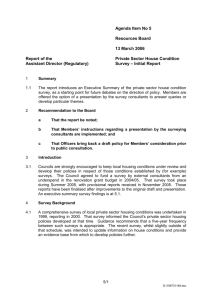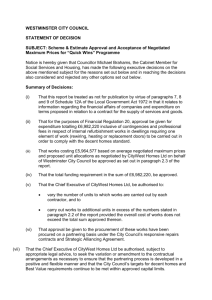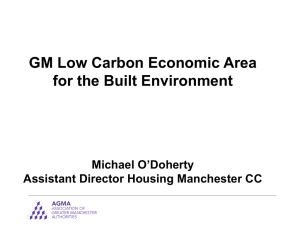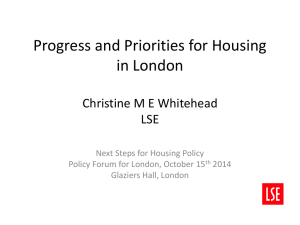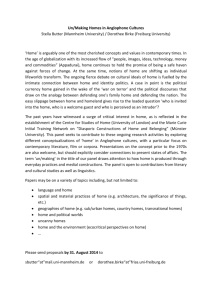Better Quality & Greener Homes - London Borough of Richmond
advertisement
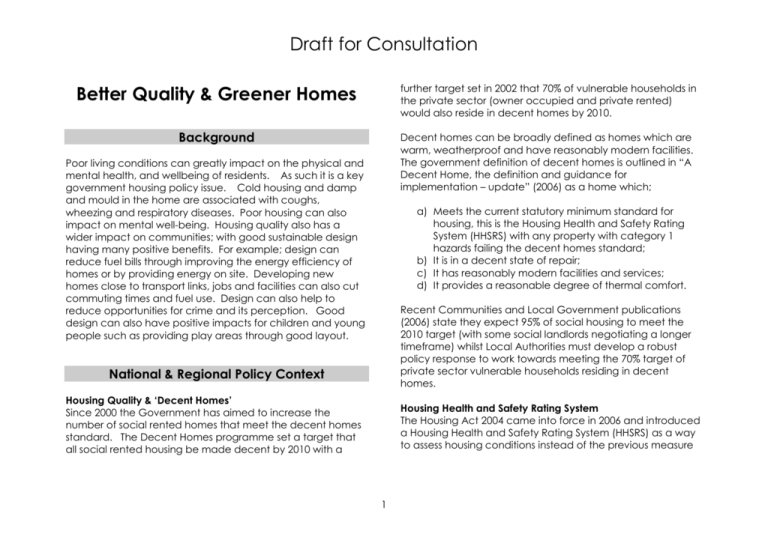
Draft for Consultation Better Quality & Greener Homes further target set in 2002 that 70% of vulnerable households in the private sector (owner occupied and private rented) would also reside in decent homes by 2010. Background Decent homes can be broadly defined as homes which are warm, weatherproof and have reasonably modern facilities. The government definition of decent homes is outlined in “A Decent Home, the definition and guidance for implementation – update” (2006) as a home which; Poor living conditions can greatly impact on the physical and mental health, and wellbeing of residents. As such it is a key government housing policy issue. Cold housing and damp and mould in the home are associated with coughs, wheezing and respiratory diseases. Poor housing can also impact on mental well-being. Housing quality also has a wider impact on communities; with good sustainable design having many positive benefits. For example; design can reduce fuel bills through improving the energy efficiency of homes or by providing energy on site. Developing new homes close to transport links, jobs and facilities can also cut commuting times and fuel use. Design can also help to reduce opportunities for crime and its perception. Good design can also have positive impacts for children and young people such as providing play areas through good layout. a) Meets the current statutory minimum standard for housing, this is the Housing Health and Safety Rating System (HHSRS) with any property with category 1 hazards failing the decent homes standard; b) It is in a decent state of repair; c) It has reasonably modern facilities and services; d) It provides a reasonable degree of thermal comfort. Recent Communities and Local Government publications (2006) state they expect 95% of social housing to meet the 2010 target (with some social landlords negotiating a longer timeframe) whilst Local Authorities must develop a robust policy response to work towards meeting the 70% target of private sector vulnerable households residing in decent homes. National & Regional Policy Context Housing Quality & ‘Decent Homes’ Since 2000 the Government has aimed to increase the number of social rented homes that meet the decent homes standard. The Decent Homes programme set a target that all social rented housing be made decent by 2010 with a Housing Health and Safety Rating System The Housing Act 2004 came into force in 2006 and introduced a Housing Health and Safety Rating System (HHSRS) as a way to assess housing conditions instead of the previous measure 1 Draft for Consultation of ‘unfitness’. The HHSRS looks at whether premises have any defects that may give rise to a hazard, which in turn could cause harm to the occupiers or any visitors. The HHSRS assesses 29 hazards and the effects that each may have on the health and safety of the occupant. The most serious hazards are classified as category 1 and less serious hazards are category 2. House condition surveys now have to consider whether HHSRS category 1 hazards exist, rather than measure levels of unfitness. Whilst unfitness has been superseded by the HHSRS it is still a useful measure in terms of analysis. Some smaller organisations may still be using the old ‘unfitness’ standard in their monitoring information submitted to the local authority. As such measures using unfitness may be required until all organisations use the HHSRS. that neighbourhoods incorporate good quality parks and green spaces. Building for Life Building for Life is the national standard for well designed homes and neighbourhoods. It is led by the Commission for Architecture and the Built Environment (CABE) and the Home Builders Federation. It is backed by the Housing Corporation, English Partnerships and Design for Homes. The Building for Life standard is made up of 20 criteria around functionality, sustainability and attractiveness, which have been developed from CABE backed guidance and government policy, such as Planning Policy Statement 3 (PPS3). Issues such as access to open spaces and play space provision are important elements of the building for life standard. The Housing Corporation requires certain schemes to meet 10 whilst others 12 of the 20 criteria before providing funding. Housing and Neighbourhood Design The Housing Green Paper “Homes for the Future: more affordable, more sustainable” (2007) outlines the need for housing and neighbourhood design to reflect the needs of society; meeting the needs of an ageing population, creating more family sized homes, ensuring adequate outdoor play spaces and ensuring housing is accessible for wheelchair users. Good design can also increase positive perceptions of areas and contribute to reducing the risk of crime. Some of these issues are addressed in the government’s “Planning Policy Statement 3 : Housing” (PPS3) such as the need for larger homes and play areas for children. “Homes for the future” also highlights the fact that homes need to be designed to be more resilient to climate change and ensure The London Plan The London Plan and its housing supplementary planning guidance (2005) sets out principles for new developments including; 2 Promoting world class architecture and design Maximising the potential for each site Enhancing the public realm Mitigating and adapting to climate change Respecting local context, history and character Promoting accessibility, sustainability and adaptability Securing safety. Draft for Consultation Inclusive Design Evidence from the Greater London Authority (2007) highlights the fact that disabled people in London are twice as likely to be living in unsuitable housing. They may have difficulties accessing new housing because of accessibility issues or the needs for adaptations to the property. Current policy promotes the concept of ‘inclusive design’ where the access needs of disabled people are integrated into the initial design of the property. This includes the concept of Lifetime Homes; which involves incorporating a set of design features which makes homes functional for everyone including older people, disabled and families. Lifetime Homes also incorporates greater leeway for future adaptations. Designing Out Crime One of the emerging themes of the new London Mayor’s housing manifesto was the need to ‘design out’ crime ensuring that new developments follow Association of Police Chief Officers (APCO) ‘Secured by Design’ principles. These are a set of design principles developed by the police to encourage the building industry to adopt crime prevention measures. PPS3 also highlights the need for local authorities to promote design and layouts that take into consideration crime and community safety, whilst all Local Authorities must consider crime and disorder implications of their activities under section 17 of the Crime & Disorder Act 1998. Secure by Design principles are part of Richmond upon Thames’ sustainable design checklist. It should be stressed however that the key design message of the checklist is that overall layout and architectural design of buildings promote overlooking and self surveillance of open spaces. It should not result in high fencing and gated developments that are inward facing and housing which turns its back on the local street/area. In “Lifetime Homes, Lifetime Neighbourhoods; A National Strategy for Homes in an Ageing Society” (2008) the government sets out targets that all affordable housing development will meet Lifetime Homes standards by 2011 and that all new private developments should aspire to meet this standard by 2013. The London Plan (2004) actually precedes this and seeks to ensure that all new homes in Greater London meet Lifetime Homes Standards and that 10% of all new homes developed should be Wheelchair Accessible. Play Space The Government has recognised the need to make better provision for children’s play space as a theme that cuts across a range of policy areas from planning, open spaces, transport and education. The Department for Children, Schools and Families published “Fair Play: a consultation on the play strategy” (2008) which sets out plans for an extra 3,500 play areas over the next three years and introduces a national Key Implication – Our Local Development Framework will ensure all new developments meet the Lifetime Homes standard and that 10% of housing developments are built to Wheelchair standards. 3 Draft for Consultation play space indicator from 2009. The paper also stresses the need for play spaces to be affordable, safe and engaging. The requirements for new developments around play spaces are set out in “Providing for Children and Young People’s Play and Informal Recreation Supplementary Planning Guidance” (2008). energy efficiency certificates which provide home buyers with detailed information on energy performance and recommendations to improve energy efficiency. From October 2008 private landlords will be required to provide energy efficiency certificates to all new tenants letting their properties. Key Implication – we will ensure the issue of play space is considered in all affordable housing developments. b) New Build Regulations The government has set a target that by 2016 all new developments will be zero carbon. To achieve this targets have been set so that by 2010 new housing developments will be expected to reduce their carbon emissions by 25% and by 2013 by 44%. This is against the baseline of current requirements set out in Building Regulations - Part L ( 2006). Although new housing developments make up only 1% of the housing stock it is estimated that by 2050 raising these requirements on new build will ensure one third of the housing stock is carbon neutral. Greener Homes In “Building a Greener Future: Policy Statement” (2007) and again in “Homes for the Future: more affordable, more sustainable” (2007) the Department for Communities and Local Government outline their policy objectives around reducing carbon emissions and increasing energy efficiency. “Building a Greener Future” highlights the fact that the emission of greenhouse gasses and in particular carbon dioxide are the main causes of climate change and that in 2005 the United Kingdom emitted 550 million tonnes of emissions, ¼ of which were directly from heating, lighting and the appliances required to run our homes. The government’s housing policy therefore has a strong emphasis on securing reduction in emissions via energy efficiency and new build regulations. Making Existing Homes ‘Greener’ The GLA report “Your Home in a Changing Climate: Retrofitting Existing Homes for Climate Change Impacts” (2008) highlights the need for existing homes to be adapted to ensure long term sustainability and meet the challenges of climate change. The Mayor’s Draft Housing Strategy (2008) also outlines proposals that social housing landlords review and develop plans on how they will tackle climate change within their existing housing stock. The Green Homes Project (2008) is a new one stop shop service, where people can access information on sustainability and energy efficiency. a) Energy Efficiency The government and energy companies currently spend £1 billion per year on energy efficiency work. Another example is the introduction of the requirement for all housing to have 4 Draft for Consultation This will be delivered by the Energy Saving Trust and rolled out from 1st April 2008. This is likely to increase knowledge and information on what individual householders can do to make their homes greener and more sustainable. In order to receive Social Housing Grant from the Housing Corporation or funding from English Partnerships to finance new affordable housing, developments have to meet the minimum of level three of the code. This is set to increase to level four by 2010 and level 6 by 2013. Sustainability The Code for Sustainable Homes (2006) was introduced to improve the overall sustainability of new homes by setting a single national standard within which the home building industry can design and construct homes to higher environmental standards. The Code measures the sustainability of a new home against categories of sustainable design, rating the ‘whole home’ as a complete package. The Code uses a 1 to 6 star rating system to communicate the overall sustainability performance of a new home. The Code sets minimum standards for energy and water use at each level and, within England, replaces the EcoHomes scheme, developed by the Building Research Institute (BRE). It also incorporates Lifetime Homes, Building for Life and Secured by Design features. Housing Corporation’s Bidding Guidance for 2008/11 Investment Programme & Housing Quality Indicators (HQI’s) All of the priorities for good quality and sustainable design that have been identified by Government are incorporated in the Housing Corporation’s Bidding Guidance for the 20082011 Investment Programme. Each new build home must meet or exceed the core standards set out in the Corporation’s current Design & Quality Standards. The Housing Quality Indicators (HQI) system is a measurement and assessment tool designed to allow potential or existing housing schemes to be evaluated on the basis of quality rather than simply, of cost. The HQI allows an assessment of quality of key features of a housing project under 3 main categories; location, design and external environment. Refurbishment & HQI In principal the Housing Corporation expects a similar high standard for all refurbishment schemes. However as many were built under different regulations they may be unable to meet the higher levels of quality on certain indicators. This does not imply that a different set of indicators is needed for refurbished dwellings, but merely that typical quality scores may be lower than for new housing. London Borough of Richmond is currently funding two exemplar schemes with Paragon Housing Association to deliver the first Level 5 Homes in the borough. The Code also gives new homebuyers better information about the environmental impact of their new home and potential running costs. 5 Draft for Consultation HQI’s in Richmond upon Thames In the initial bidding round and regular market engagement rounds of the Housing Corporation programme, schemes in the borough have achieved very high HQI scores for both new build and rehabilitation schemes. 187 Tackling Fuel Poverty – people receiving income based benefits National Indicator Set (2008) Following the Government’s white paper “Strong & Prosperous Communities” the Government has published a national indicator set of 185 Indicators with a further 13 to be published in 2009/10. Of these the following indicators that Local Authorities have to report back on are relevant to “Better Quality & Greener Homes”. 188 Adaptation to Climate Change 199 Children & Young People’s satisfaction with parks and play areas National Indicators relevant to “Better Quality & Greener Homes” NI Definition 138 Satisfaction of People over 65 with both home & neighbourhood 186 Per Capita Emissions in the Local Authority Area How Housing Strategy contributes to Indicator Disabled Facility Grants & Home Improvement Agency work New housing development and energy efficiency on existing homes. Residential Services team lead such as via Cold Buster grants for vulnerable residents. Work of sustainability team in tackling climate change. Planning/ housing development contribute with regard to incorporating play areas in design. Key Implication – The Residential Services Team via their energy efficiency work are directly responsible for delivering against National Indicator 187 whilst the Sustainability Team are directly responsible for National Indicators 186 and 187. Local Policy Context Community & Corporate Plans One of seven key priorities of the Community Plan 2007 to 2017 is to ‘be the greenest borough in London’. Key actions include improving the energy performance of existing 6 Draft for Consultation buildings, tackling climate change and ensuring new housing development is to a high environmental standard. The Corporate Plan 2007 – 2010 has five priorities the first of which is ‘Environment and Sustainability’. Key objectives include cutting carbon emissions, sustainability and promoting energy efficiency. Supplementary Planning Document” (2006) which highlights the importance of good quality design covering such issues as local character, the public realm, sustainability and inclusive design. The Sustainability Construction Checklist is central to this and was adopted by the Corporate Plan as a key principle of sustainable design. This is an 18 point checklist which requires developments to meet ‘Ecohomes’ standard or the Building Research Institute (BRE) excellent rating. It also incorporates other factors such as recycling, cycle storage, use of public transport and Secured by Design principles. All residential schemes are assessed against this checklist. The borough also has an established Councillor as ‘design champion’. Local Development Framework The Local Development Framework (LDF) Core Strategy is currently in development and has been submitted to the Secretary of State. Key policy ‘preferred options’ include Core Policy 2; Reducing Carbon Emissions (including reducing carbon emissions from within existing and new buildings, continuing the operation of the Sustainable Construction Checklist & increasing renewable energy within buildings). Core Policy 3 – Adapting to the effects of Climate Change includes ensuring climate change and flooding issues are incorporated into development decisions. Core Policy 7 – Maintaining and Improving the Local Environment outlines that all new housing development should recognise local character and create places of high architectural and urban design quality whilst Core Policy 14 – Housing Provision states the need for all housing to be built to Lifetime Homes Standard with 10% built to Wheelchair Accessible standards. Climate Change Strategy (2008) London Borough of Richmond upon Thames developed a Climate Change strategy in 2008. Its vision is to make Richmond upon Thames the greenest borough in London and includes a range of measures aimed to reduce greenhouse emissions and raise awareness of climate change. The strategy outlines how the Council has a key role to play in tackling climate change through reducing its own impact and taking a leadership role to enable residents to take action. It also discusses the business case for reducing greenhouse emissions, such as reduced fuel bills and quality of life arguments, such as better air quality. The strategy will be updated in 2009 to cover issues around adapting to climate change. Design Quality – Supplementary Planning Document & the Sustainability Construction Checklist There are several Planning documents which all promote “Better Quality and Greener Homes”. The key document for Richmond upon Thames is the “Design Quality – 7 Draft for Consultation Housing Health & Safety Rating System In 2006, the Building Research Establishment estimated that 23% (16,064) properties in the borough had category 1 hazards. They also reported that 26% (17,974) of properties failed in respect of thermal comfort, so it is assumed that a substantial number of the category 1 failures were due to ‘excess cold’. For comparison in 2006 the sub regional percentage of homes failing the decent homes standard due to ‘thermal comfort’ reasons was estimated at 28% (SW London Private Sector Housing Strategy 2006) whilst the UK average estimate is 26% (English House Condition Survey 2005). Key Implication - Sustainability and a Greener Richmond are key priorities of the Council – we will continue to prioritise working towards sustainability and greener housing for both new build and existing homes. The Council’s approach to sustainability is also embedded within “Greener Richmond”, a thematic subgroup of the Local Strategic Partnership. Key Findings from the Housing Strategy Evidence Base Key Implication – The local authority is responsible for enforcing the HHSRS in the borough – we will continue to develop our expertise around private sector house conditions. House Conditions With a large owner occupied and private rented sector poor house conditions are a key housing issue affecting the borough. The age of the housing stock and the number of older residents (some of whom are on Rent Act Protected Tenancies with low rents so there is no incentive for landlords to improve properties) are all key issues. Properties that previously failed the ‘unfitness standard’ are scattered throughout the borough rather than concentrated in particular wards or areas. Implementation of the HHSRS The HHSRS system has bedded down well in the borough with few statutory notices (as landlords are signing undertakings to attend to works) although many landlords are not aware of the detail of enforcement policy. Following on from the BRE findings there is no pattern as to where hazardous properties are in the borough. A number of properties have both Category 1 and Category 2 hazards. Key Implication – With an ageing housing stock, large owner occupied and private rented sectors and a high number of older residents we will address private sector house conditions through the work of the Residential Services & Sustainability Teams. Key Implication – We will continue to support landlords in the private sector to improve quality whilst targeting intervention in the worst circumstances of the private sector. 8 Draft for Consultation Decent Homes in the Housing Association Sector The number of housing association properties in the borough that do not meet the decent homes standard has declined for the last three years from 1562 in March 2005 to 662 properties in March 2007. Decent Homes in the Private Sector A survey carried out by the Building Research Establishment (BRE) on behalf of the borough in 2003 found 38% properties did not reach the decent homes standard. It should be noted however that since this date unfit properties have declined from an estimated 4,500 in 2003 to 3,543 in 2007. Since the introduction of the HHSRS Category 1 system (as a replacement for unfitness) as part of the decent homes standard there is likely to be an increase in the number of non decent homes in the private sector. This is because more homes have category 1 hazards than were unfit under the old standard. Therefore levels of non decent homes may actually increase under the new survey which will take place later in 2008. Non Decent Homes in the Housing Association Sector 2000 1500 1000 500 0 Number of Non Decent Homes 2005 RSR Return 2006 RSR Return 2007 RSR Return 1562 1121 662 As part of the work of the Residential Services Team and Home Improvement Agency a number of non decent homes occupied by vulnerable households are made decent each year. Sometimes properties are only made partially decent, this occurs where a landlord or owner refuses additional work to the property. The table below highlights the numbers of properties in the private sector made decent by household type. Source; RSR 2005, 2006 & 2007 Return The borough has lower than the English average number of non decent housing association properties. The two largest housing associations in the borough have significantly decreased the percentage of non decent housing association properties in the borough. Housing associations with medium or small stock portfolios in the borough are in general meeting the decent homes standard. The Residential services team helped 108 vulnerable households in 2006/07 to improve their homes to a decent condition Key Implication – Housing associations in the borough have delivered well on the decent homes agenda. We will continue to support their work in delivering decent homes. 9 Draft for Consultation Homes made Decent for vulnerable households in the private sector Energy Efficiency and SAP Ratings SAP rating stands for ‘Standard Assessment Procedure’ rating. It is an index of the annual cost of heating a dwelling to achieve a standard heating regime. The index runs from 1 (highly inefficient) to 120 (highly efficient). It is dependent on both the heat loss from the dwelling and the performance of the heating system. 120 100 80 SAP ratings in the private sector have improved over the last five years from an average of 47 in 2003 to an average of 54 in 2007. It is estimated however that 9% of private sector dwellings have a SAP rating of below 35 (HSSA 2007). SAP ratings have improved in both the social and private sectors. 60 40 20 0 2004/05 2005/06 2006/07 Total Number 98 113 108 Pensioners 78 77 62 Families with Children 20 35 18 Other 0 1 28 SAP ratings are higher in the Housing Association sector compared to the private sector. Within the private sector SAP ratings within the borough are slightly higher than that found in most of the sub region Energy Efficiency and C02 Emissions There has been a 16.11% improvement in energy efficiency across all tenures between 1st April 1996 to 31st March 2007. In the year April 2006 to March 2007 there was an annual improvement in energy efficiency of 2.7%. There has also been a reduction in Co2 emissions from dwellings between April 2006 and March 2007 of 9306 tonnes. Source; HSSA Returns 2005, 2006, 2007 It should be noted that the 2003 survey found no area ‘pockets’ or wards where non decent homes were concentrated, rather they were ‘pepper potted’ around the borough. 10 Draft for Consultation central heating (Census 2001). For Pensioners the figure is 13% of households who lack central heating (Census 2001). The majority of these are single person households (75%) followed by pensioner couples (22%). Highest levels of pensioner households lacking central heating can be found in West Twickenham (20%), Kew (19%), Fulwell and Hampton Hill (17%), Mortlake and Barnes (17%) and St Margarets and North Twickenham (17%). Key Implication – There has been an estimated 16% improvement in energy efficiency across all tenures in the borough between 1996 and 2007. We will continue to prioritise energy efficiency work to create greener and more sustainable homes. Fuel Poverty Fuel Poverty is defined as where households have to spend 10% or more of their income on household fuel to achieve a comfortable temperature. National reports highlight that those in the private rented sector have the highest levels of fuel poverty, at 9% compared to 6% for all tenures (The Poverty Pensioners living in the private rented sector have significantly higher levels of households lacking central heating (40%). Whilst numbers are small (and caution needs to be used in interpreting data due to very small sample size) wards such as East Sheen, Kew, St Margarets, Teddington and South Twickenham show significantly higher rates of pensioner households living in private rented accommodation without central heating. Site, 2004 statistic). The 2006 BRE report estimated that households living in 4,489 or 6% of the boroughs properties suffer from fuel poverty. Lack of Central Heating Lack of central heating can be used as an indicator of a properties condition. They are more likely in need of modernisation, may not meet the decent homes standard criteria on thermal comfort and there is also a greater likelihood of damp and condensation (The Poverty Site 2007). Nationally households living in the private rented sector are twice as likely to be living in a property with no central heating with 1 in 4 pensioner private renters residing in properties without central heating (Rhodes 2006). Key Implication – Vulnerable households in the private sector, such as some older people, are often living without central heating or in poor conditions. With limited resources we will continue to prioritise improving the quality of homes, focusing on the most vulnerable. In Richmond upon Thames the majority of households have central heating (92.5%) with the remainder (7.5%) lacking 11 Draft for Consultation Actions Key Objectives 1. Improve the quality of existing homes, especially amongst the most vulnerable. 1. Improve the quality of existing homes, especially amongst the most vulnerable. 1 2. Support landlords to improve quality. 2 Increase the number of homes that are adapted to meet the needs of disabled or vulnerable people by 120 Disabled Facilities Grants (DFG’s) during 2008/09. Increase the number of homes that are adapted to meet the needs of disabled or vulnerable people by 120 Disabled Facilities Grants (DFG’s) in 2009/10. Ensure 130 homes are made decent or partially decent as a result of Local Authority activity 2008/09 Ensure the average time to complete Disabled Facility Grants is 27 weeks (from initial enquiry to actual approval). Deal with 50 Category 1 and 2 Hazards under the HHSRS 2008/09 2009/10 3. Target intervention in the worst circumstances of the private sector. 3 4. Improve energy efficiency & sustainability within existing homes. 4 5. Increase our research understanding around private sector housing issues. 5 6. Promote good quality sustainable design which is inclusive, helps lower crime and promotes greener homes. 6 Work with BME community groups to highlight the work of the Home Improvement Agency (HIA). 2009/10 7 Ensure HIA clients are supported throughout the process of home improvement. 2008/09 8 Ensure HIA clients are signposted to relevant advice & housing options services. 2008/09 9 Bid for funding for decent homes in the private sector under the 2008-2011 GLA Regional Housing 2008/09 7. Continuing to develop our work expertise on private sector housing. 8. Maintain strong partnership working on public and private sector housing issues. 12 2008/09 2008/09 Draft for Consultation 10 pot targeted funding stream. Carry out benchmarking activity to demonstrate value for money in the delivery of Disabled Facility Grants. with relatively high percentages of non decent homes. 2010/11 3. Target intervention to tackle the worst circumstances in the private sector. 2. Support landlords to improve quality. 1 Continue to work with landlords taking enforcement action only when necessary to improve private rented homes. Offer grants to landlords that meet required criteria and undertake to carry out works in given timescales. Continue to support the London Landlord Accreditation scheme. 2008/09 Offer Landlord Accreditation Training two times per year (15 landlords each) ensuring the prioritisation of landlords of vulnerable tenants. Promote and resource the Landlords Forum including producing two newsletters. 2008/09 6 Ensure 100% of Richmond Housing Partnership’s housing stock meets the decent homes standard. 2009/10 7 Ensure 100% of Richmond Churches stock meets the decent homes standard. 2009/10 8 As part of quarterly liaison meetings with Housing Associations ensure agenda item of decent homes – focusing on the small number of RSL’s 2008/09 & Ongoing 2 3 4 5 1 Ensure all known HMO’s are inspected for compliance with licensing requirements (two year programme). Carry out HHSRS inspections responding to tenant complaints. 2008/09 3 Revise and Publish Enforcement Policy. 2008/09 4 Publish detailed guidelines for landlords regarding hazards and the HHSRS. 2009/10 2 2008/09 2008/09 2008/09 2008/09 4. Improve energy efficiency & sustainability within existing homes. 1 2 3 13 Hold 20 energy efficiency training sessions a year, 10 with organisations working with the fuel poor and 10 with groups working with the fuel rich Carry out 250 energy efficiency (Cold Busters and Warm Front) grants in 2008/09. 2008/09 & Ongoing 2008/09 Carry out 250 Energy Efficiency (Cold Busters and Warm Front) Grants in 2009/10. 2009/10 Draft for Consultation 4 5 6 7 8 9 10 11 12 13 Provide 3,000 advice packs to households suffering fuel poverty (from HECA sample). 2008/09 Fund home visitor officer for 2009/10 focusing on private sector properties in Mortlake & East Sheen to carry out energy checks, check heating systems, advise on grant availability, fuel poverty and insulation. Co-Ordinate & resource the Fuel Poverty Strategy Group. 2009/10 Develop a comprehensive home energy database using completed home energy surveys and home energy reports. Carry out analysis using GIS to inform our strategic knowledge around home energy and the borough. Promote the Green Home Concierge Service to 1000 home owners in the borough. 2008/09 Work with Warmzone to offer 1000 private sector residents discounted loft and cavity wall insulation (free to residents aged 70+ or on certain benefits). Work with retailers, installers, energy utilities and the GLA to make available and promote discounted energy efficiency & micro generation schemes to householders. Provide information for private landlords about energy efficiency. 2008/09 Carry out a mail-shot to promote private sector grant schemes focusing on vulnerable residents. 2008/09 14 Hold a conference with Housing Association partners on adapting social housing stock to climate change. 2009/10 5. Increasing our research understanding around private sector house conditions. 2008/09 1 Carry out BRE Survey of Private Sector Stock Conditions. 2008/09 2 Research the likely future demand for Disabled Facility Grants. 2009/10 2009/10 6. Promote good quality sustainable design which is inclusive, helps lower crime and promotes greener homes. 2008/09 1 2 2008/09 3 2008/09 4 14 Ensure ‘Secure by Design’ Principles are incorporated into all affordable housing developments. All borough funded affordable housing developments should broadly follow the development standards set out by the Housing Corporation in terms of space standards and design. Work with Housing Associations to ensure they are all aware of the Sustainability Construction Checklist. Ensure all developers follow the Sustainable Construction Checklist. 2008/09 2008/09 2008/09 2008/09 Draft for Consultation 5 Ensure all new dwellings meet Lifetime Homes Standards. 2008/09 2 Environmental Health Officers to attend advanced training on HHSRS. 2008/09 6 Require 10% of all new dwellings be built to Wheelchair Standards. 2008/09 3 Continue to develop an assessment panel to ensure a standardised approach to HHSRS and HMO licensing. 2008/09 7 Ensure all affordable housing developments consider the need for children’s play space. 2009/10 8 Promote sustainable house extensions and renewable energy to private sector housing through new planning and guidance. Encourage developers to liaise with Housing Associations at Pre Planning Application stage. 2008/09 Invite a variety of speakers to the Housing Association Forum to promote and inform RSL’s on the most recent research and policy on sustainable development. Work with RSL’s to ensure all residents living in new developments are given adequate information about waste recycling facilities on site. Explore using the Housing Capital Programme to fund schemes that meet higher levels of the Code For Sustainable Homes. 2009/10 9 10 11 12 8. Maintain strong partnership working on private & public sector housing issues. 1 2008/09 2 3 2009/10 2009/10 7. Continuing to develop our work expertise on private sector housing. 1 Ensure all new Environmental Health Officers are trained and certified as competent to carry out HHSRS assessments. 2008/09 15 To maintain strong partnership working with other boroughs in the sub-region on private sector housing issues. To work with HouseProud and CEN. 2008/09 To ensure sustainability and design issues are key to all development discussions at the Housing Association Forum and at quarterly meetings with all housing associations in the borough. 2008/09 2008/09 Draft for Consultation Better Quality & Greener Homes 2. Do you agree with the key actions on pages 12-15? 1. Do you agree with the key objectives on page 12? please please tick a box tick a box Yes Yes No if no please tell us why in the box below 16 No if no please tell us why in the box below Draft for Consultation 3. The council only has limited resources and may not be able to deliver all of the actions. Which actions do you think should be a priority? please use the box below 5. Please use the box below to give us any other views or comments you have about this chapter. 4. Is there anything else you think we should make a priority? please tick a box No Yes if yes please tell us more in the box below Thank you for your feedback. It will help us to ensure that the strategy reflects the views of our partners in the borough. Please email your response to : tracy.stanley@richmond.gov.uk 17 Tracy Stanley, Policy Research & Statistics Officer, LBRUT Tel : 0208 891 7762

